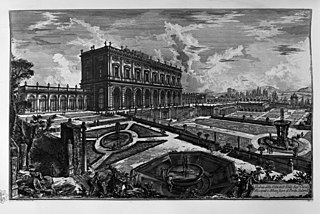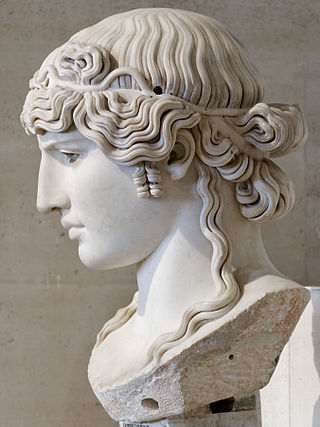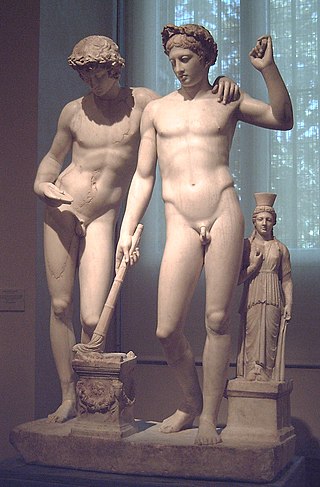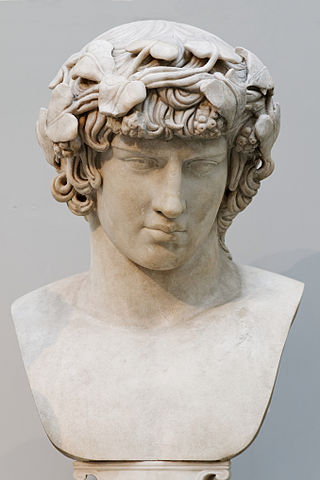
The Quirinal Hill is one of the Seven Hills of Rome, at the north-east of the city center. It is the location of the official residence of the Italian head of state, who resides in the Quirinal Palace; by metonymy "the Quirinal" has come to stand for the Italian president. The Quirinal Palace has an extension of 1.2 million square feet.

Antinous, also called Antinoös, was a Greek youth from Bithynia and a favourite and lover of the Roman emperor Hadrian. Following his premature death before his twentieth birthday, Antinous was deified on Hadrian's orders, being worshipped in both the Greek East and Latin West, sometimes as a god and sometimes merely as a hero.

The Discobolus by Myron is an Ancient Greek sculpture completed at the start of the Classical period at around 460–450 BC. The sculpture depicts a youthful male athlete throwing a discus. The bronze Greek original is lost. The work is known through its numerous Roman copies, both full-scale ones in marble, which is cheaper than bronze, such as the first to be recovered, the Palombara Discobolus, and smaller scaled versions in bronze.

Hadrian's Villa is a UNESCO World Heritage Site comprising the ruins and archaeological remains of a large villa complex built c. AD 120 by Roman Emperor Hadrian at Tivoli outside Rome. The site is owned by the Republic of Italy and has been managed since 2014 by the Polo Museale del Lazio.

The life-size ancient but much restored marble statue known as the Barberini Faun, Fauno Barberini or Drunken Satyr is now in the Glyptothek in Munich, Germany. A faun is the Roman equivalent of a Greek satyr. In Greek mythology, satyrs were human-like male woodland spirits with several animal features, often a goat-like tail, hooves, ears, or horns. Satyrs attended Dionysus.

The Ludovisi Ares is an Antonine Roman marble sculpture of Mars, a fine 2nd-century copy of a late 4th-century BCE Greek original, associated with Scopas or Lysippus: thus the Roman god of war receives his Greek name, Ares.

The Villa Albani is a villa in Rome, built on the Via Salaria for Cardinal Alessandro Albani. It was built between 1747 and 1767 by the architect Carlo Marchionni in a project heavily influenced by others – such as Giovanni Battista Nolli, Giovanni Battista Piranesi and Johann Joachim Winckelmann – to house Albani's collection of antiquities, curated by Winckelmann. The villa has been conserved intact into the 21st century by the Torlonia Family, who bought it in 1866. In 1870, the treaty following the Capture of Rome from the Papal States was signed here.

The Antinous Mondragone is a 0.95-metre high marble example of the Mondragone type of the deified Antinous. This colossal head was made sometime in the period between 130 AD to 138 AD and then is believed to have been rediscovered in the early 18th century, near the ruined Roman city, Tusculum. After its rediscovery, it was housed at the Villa Mondragone as a part of the Borghese collection, and in 1807, it was sold to Napoleon Bonaparte; it is now housed in the Louvre in Paris, France.

The Capitoline Venus is a type of statue of Venus, specifically one of several Venus Pudica types, of which several examples exist. The type ultimately derives from the Aphrodite of Cnidus. The Capitoline Venus and her variants are recognisable from the position of the arms—standing after a bath, Venus begins to cover her breasts with her right hand, and her groin with her left hand.

The Hermes of the Museo Pio-Clementino is an ancient Roman sculpture, part of the Vatican collections, Rome. It was long admired as the Belvedere Antinous, named from its prominent placement in the Cortile del Belvedere. It is now inventory number 907 in the Museo Pio-Clementino.

The Castor and Pollux group is an ancient Roman sculptural group of the 1st century AD, now in the Museo del Prado, Madrid.

Bartolomeo Cavaceppi was an Italian sculptor who worked in Rome, where he trained in the studio of the acclimatized Frenchman, Pierre-Étienne Monnot, and then in the workshop of Carlo Antonio Napolioni, a restorer of sculptures for Cardinal Alessandro Albani, who was to become a major patron of Cavaceppi, and a purveyer of antiquities and copies on his own account. The two sculptors shared a studio. Much of his work was in restoring antique Roman sculptures, making casts, copies, and fakes of antiques, fields in which he was pre-eminent and which brought him into contact with all the virtuosi: he was a close friend of and informant for Johann Joachim Winckelmann. Winckelmann's influence and Cardinal Albani's own evolving taste may have contributed to Cavaceppi's increased self-consciousness of the appropriateness of restorations — a field in which earlier sculptors had improvised broadly — evinced in his introductory essay to his Raccolta d'antiche statue, busti, teste cognite ed altre sculture antiche restaurate da Cav. Bartolomeo Cavaceppi scultore romano. The baroque taste in ornate restorations of antiquities had favoured finely pumiced polished surfaces, coloured marbles and mixed media, and highly speculative restorations of sometimes incongruous fragments. Only in the nineteenth century, would collectors begin for the first time to appreciate fragments of sculpture: a headless torso was not easily sold in eighteenth-century Rome.

The Furietti Centaurs are a pair of Hellenistic or Roman grey-black marble sculptures of centaurs based on Hellenistic models. One is a mature, bearded centaur, with a pained expression, and the other is a young smiling centaur with his arm raised. The amorini are missing that once rode the backs of these centaurs, which are the outstanding examples of a group of sculptures varying the motif.

Giuseppe Alessandro Furietti was a Roman Catholic cardinal, an antiquarian and philologist, and a collector of antiquities whose ambitious excavations at the site of Hadrian's Villa at Tivoli rewarded him with the Furietti Centaurs and other Roman sculpture.

The sculptures of Hermes Fastening his Sandal, which exist in several versions, are all Roman marble copies of a lost Greek bronze original in the manner of Lysippos, dating to the fourth century BCE. The identity of the subject, which may simply represent an idealized athlete, is conventional. No attribute in any of the surviving examples clearly identifies Hermes, who wears neither hat nor helmet; none of the surviving original sandals are represented as winged. A pair of sandals figures in the myth of Theseus, and when the painter-dealer Gavin Hamilton uncovered an example in the swamp ground called the Pantanello at Hadrian's Villa at Tivoli in 1769, he hesitated between calling it a Theseus or a Cincinnatus. Jason's myth also involves a lost sandal. When Augustus Hare saw that sculpture in the Ball Room of Lansdowne House, in Berkeley Square, he noted it as "Jason fastening his sandal."
Conte Giuseppe Fede was an Italian nobleman, collector and archaeologist of the 18th century. As early as 1724 he started to buy up parcels of land on the site of Hadrian's Villa at Tivoli and excavate on them. Like his father, he was a collector-excavator who retained some of the sculptures he excavated for himself whilst releasing others onto the antiquarian market.
Antinous was the favorite and lover of Roman Emperor Hadrian.

The marble Cupid and Psyche conserved in the Capitoline Museums, Rome, is a 1st or 2nd century Roman copy of a late Hellenistic original. It was given to the nascent Capitoline Museums by Pope Benedict XIV in 1749, shortly after its discovery. Its graceful balance and sentimental appearance made it a favourite among the neoclassical generations of artists and visitors, and it was copied in many materials from bronze to biscuit porcelain. Antonio Canova consciously set out to outdo the Antique original with his own Cupid and Psyche of 1808

The Townley Antinous is a marble portrait head of the Greek youth Antinous, the boyfriend or lover of the Roman Emperor Hadrian, wearing an ivy wreath. It is now part of the collection of London's British Museum, and was part of the Townley Marbles. Only the head is ancient, once belonging to statue dating from c. 130–140 and the late reign of Hadrian ; the bust is a modern addition. The portrait probably shows the youth as Dionysus–Bacchus. The bust was acquired along with the rest of the antiquities collected by 18th-century Grand Tourist and Fellow of the Royal Society, Charles Townley. A drawing of the bust attributed to Vincenzo Pacetti is also in the museum's collection.
The Torlonia Collection is a private art collection of 620 Ancient Greek and Roman art works assembled by the noble Torlonia family of Rome, Italy. It has been called "the greatest private collection of ancient Roman antiquity" by archaeologist Darius Arya. Around 180 pieces are busts, one of the largest collections of Roman portraiture in the world.

















